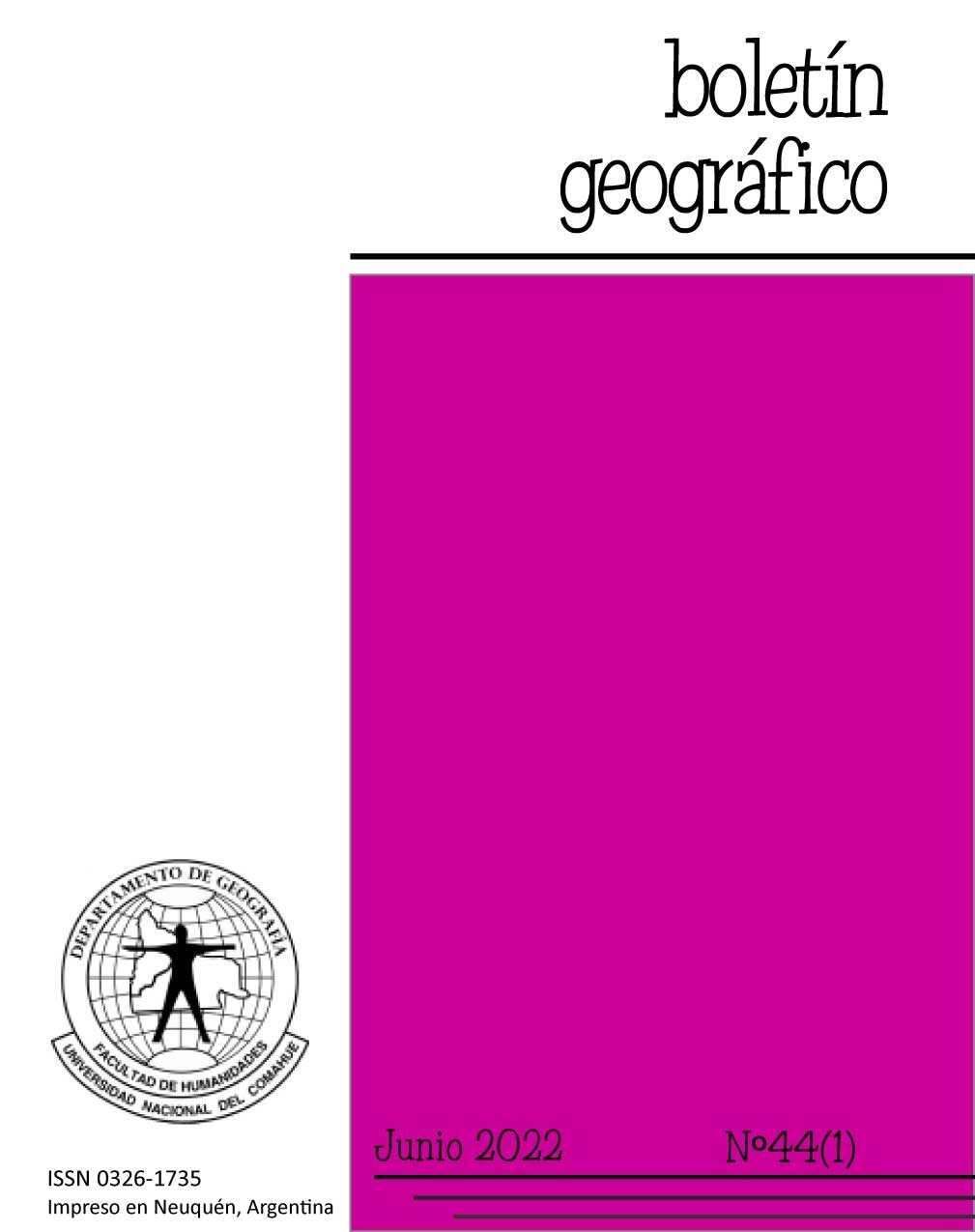Evaluación de variables meteorológicas para la caracterización climática de la región de Cuyo (Argentina)
Palabras clave:
Datos Meteorológicos, Correcciones Estadísticas, Caracterización Climática, CuyoResumen
El cambio climático y el evidente calentamiento global hacen que la caracterización climática a escala regional sea un elemento indispensable para conocer los impactos negativos que se podrían generar sobre las actividades económicas. En este contexto, adquieren importancia las regiones áridas debido a que son más susceptibles a los efectos de la variabilidad climática. Para su estudio, son necesarias series climáticas de al menos 30 años. En ciertas ocasiones estas suelen ser escasas o incompletas. Por tal motivo, los modelos climáticos surgen como una herramienta que favorecen la generación de esta información. Por ello, en este trabajo se estudió el ajuste entre los datos de variables climáticas obtenidas del Renalysis y las observadas In situ, considerando una escala climática (1960-2020) y otra estacional. Para ello, se compararon series de datos mensuales de Temperatura del aire, Humedad relativa y Precipitación medidas In situ pertenecientes a nueve estaciones meteorológicas con series adquiridas del Reanalysis. Se aplicaron dos escalas de análisis. En una primera instancia, los datos se contrastaron y evaluaron estadísticamente a escala climática, es decir, considerando el período 1960-2020. Luego, se estudiaron los ajustes estacionales a escala regional. Como resultado, se obtuvo que la Temperatura del aire y la Precipitación fueron las variables que presentaron buenos ajustes estadísticos en ambas escalas de análisis. La Humedad relativa no tuvo resultados significativos. Se demostró que es posible corregir los datos del Reanalysis para la caracterización climática de la Región de Cuyo. La información generada conforma una base de datos sólida para el diseño de un plan de manejo del espacio enmarcado dentro de los lineamientos del desarrollo sustentable.
Descargas
Citas
Abatzoglou, J. T., & Brown, T. J. (2012). A comparison of statistical downscaling methods suited for wildfire applications. International Journal of Climatology, 32(5), 772-780.
Aliaga, V. S., Ferrelli, F., & Piccolo, M. C. (2017). Regionalization of climate over the Argentine Pampas. International journal of climatology, 37, 1237-1247.
Aliaga, V., Ferrelli, F., Alberdi Algarañaz, E.D., Bohn, V. Y. & Piccolo, M. C. 2016. Distribución y variabilidad de la precipitación en la región pampeana argentina. Cuadernos de Investigación Geográfica, 42 (1), 261-280.
Araya-Osses, D., Casanueva, A., Roman-Figueroa, C., Uribe, J. M., & Paneque, M. (2020). Climate change projections of temperature and precipitation in Chile based on statistical downscaling. Climate Dynamics, 54(9), 4309-4330.
Beck, H. E., Zimmermann, N. E., McVicar, T. R., Vergopolan, N., Berg, A., & Wood, E. F. (2018). Present and future Köppen-Geiger climate classification maps at 1-km resolution. Scientific data, 5, 180214.
Brendel, A. S., Ferrelli, F., Piccolo, M. C., & Perillo, G. M. E. (2021). Efectos de la variabilidad pluviométrica sobre la morfometría de los recursos hídricos de una cuenca hidrográfica de la Región Pampeana (Argentina). Revista Geográfica Venezolana. 62 (1), 92-106.
Brendel, A., Bohn, V. Y., & Piccolo, M. C. (2017). Efecto de la variabilidad climática sobre el estado de la vegetación y la cobertura de agua en una cuenca de clima templado (Argentina). ANUÃRIO DO INSTITUTO DE GEOCIENCIAS, 40, 5 – 16.
Bustos M.L., Ferrelli, F., Huamantinco Cisneros, M. A., Piccolo, M. C. & Gil, V. (2016). Estudio preliminar del ajuste entre datos meteorológicos in situ y del Reanálisis (NCEP/NCAR) en distintos ambientes de la provincia de Buenos Aires, Argentina. Estudios Geográficos, Vol. LXXVII, 280, 335-343.
Collazo, S., Barrucand, M., & Rusticucci, M. (2019). Summer seasonal predictability of warm days in Argentina: statistical model approach. Theoretical and Applied Climatology, 138(3-4), 1853-1876.
Devers, A., Vidal, J. P., Lauvernet, C., Graff, B., & Vannier, O. (2020). A framework for high‐resolution meteorological surface reanalysis through offline data assimilation in an ensemble of downscaled reconstructions. Quarterly Journal of the Royal Meteorological Society, 146(726), 153-173.
Ferrelli, F. (2017). Variabilidad pluviométrica y sus efectos sobre las coberturas del suelo al sur de la provincia de Buenos Aires, Argentina. Revista Geográfica Venezolana, 58 (1), 26-37.
Ferrelli, F. Bustos, M. L., Perillo, G.M.E. & Piccolo, M. C. (2021b). Evaluación de variables meteorológicas obtenidas del Reanalysis (NCEP/NCAR) para el estudio del clima de ciudades costeras de Argentina. Investigaciones Geográficas. 76, 263-284.
Ferrelli, F., Brendel, A. S., Aliaga, V. S., Piccolo, M. C., & Perillo, G. M. E. (2019). Climate regionalization and trends based on daily temperature and precipitation extremes in the south of the Pampas (Argentina). Geogr Res Lett 45: 393–416.
Ferrelli, F., Brendel, A.S., Perillo, G.M.E. & Piccolo, M. C. (2021a). Warming signals emerging from the analysis of daily changes in extreme temperature events over Pampas (Argentina). Environmental Earth Sciences. 80, 422.
Haylock, M. R., Cawley, G. C., Harpham, C., Wilby, R. L., & Goodess, C. M. (2006). Downscaling heavy precipitation over the United Kingdom: a comparison of dynamical and statistical methods and their future scenarios. International Journal of Climatology: A Journal of the Royal Meteorological Society, 26(10), 1397-1415.
Houghton R. A. (1993). Is carbon accumulating in the northern temperate zone? Global Biogeochem Cycles, 7, 611–700.
Hwang, S., & Graham, W. D. (2013). Development and comparative evaluation of a stochastic analog method to downscale daily GCM precipitation. Hydrology and Earth System Sciences, 17(11), 4481-4502.
Jeon, S., Paciorek, C. J., & Wehner, M. F. (2016). Quantile-based bias correction and uncertainty quantification of extreme event attribution statements. Weather and Climate Extremes, 12, 24-32.
Kalnay, E., Kanamitsu, M., Kistler, R., Collins, W., Deaven, D., Gandin, L., Iredell, M., Saha, S., White, G., Woollen, J., Zhu, Y., Chelliah, M., Ebisuzaki, W., Higgins, W., Janowiak, J., Mo, K. C., Ropelewski, C., Wang, J., Leetmaa, A., Reynolds, R., Jenne, R. & Joseph, D. (1996). The NCEP/NCAR 40-year reanalysis project. Bulletin of the American Meteorological Society, 77(3), 437-472.
Kim, K. Y., Kim, J., Boo, K. O., Shim, S., & Kim, Y. (2019). Intercomparison of precipitation datasets for summer precipitation characteristics over East Asia. Climate Dynamics, 52(5-6), 3005-3022.
Kistler, R., Kalnay, E., Collins, W., Saha, S., White, G., Woollen, J., Chelliah, M., Ebisuzaki, W., Kanamitsu, M., Kousky, V., van den Dool, H., Jenne, R. & Fiorino, M. (2001). The NCEP–NCAR 50-year reanalysis: monthly means CD-ROM and documentation. Bulletin of the American Meteorological society, 82(2), 247-268.
Libanda, B., Bwalya, K., Nkolola, N. B., & Chilekana, N. (2020). Quantifying long-term variability of precipitation and temperature over Zambia. Journal of Atmospheric and Solar-Terrestrial Physics, 198, 105201.
Nacar, S., Kankal, M., & Okkan, U. (2019). Statistical Downscaling of Monthly Mean Air Temperature Using NCEP/NCAR Re-analysis Data: A Case Study for the Eastern Black Sea Basin. In 3rd International Conference on Advanced Engineering Technologies.
Penalba O.C. & Rivera J.A. (2016). Regional aspects of future precipitation and meteorological drought characteristics over Southern South America projected by a CMIP5 multi‐model ensemble. International Journal of Climatology, 36(2), 974-986
Romero, P. E., González, M. H., Rolla, A. L., & Losano, F. (2020). Forecasting annual precipitation to improve the operation of dams in the Comahue region, Argentina. Hydrological Sciences Journal, 1-10.
Rusticucci, M. M., & Kousky, V. E. (2002). A comparative study of maximum and minimum temperatures over Argentina: NCEP–NCAR reanalysis versus station data. Journal of Climate, 15(15), 2089-2101.
Sachindra, D. A., Ahmed, K., Mamunur Rashid, M., Sehgal, V., Shahid, S., & Perera, B. J. C. (2019). Pros and cons of using wavelets in conjunction with genetic programming and generalised linear models in statistical downscaling of precipitation. Theoretical and Applied Climatology, 138(1-2), 617-638.
Seo, S. B., & Kim, Y. O. (2018). Impact of spatial aggregation level of climate indicators on a national-level selection for representative climate change scenarios. Sustainability, 10(7), 2409.
Taboada M. A., Damiano, F. & Micucci, F. G. (2012). Aspectos físicos que condicionan la disponibilidad de agua para los cultivos. Facultad de Agronomía, UBA. Buenos Aires. 133-167.
Viggiano, M., Busetto, L., Cimini, D., Di Paola, F., Geraldi, E., Ranghetti, L., Ricciardelli, E & Romano, F. (2019). A new spatial modeling and interpolation approach for high-resolution temperature maps combining reanalysis data and ground measurements. Agricultural and Forest Meteorology, 276, 107590.
Wang B., Zhang M.,Wei J.,Wang S.J., Li S.S., Ma Q., L. X.F. & Pan S.K. (2013).Changes in extreme events of temperature and precipitation over Xinjiang, Northwest China, during 1960–2009. Quatern Int 298:141–151.
Wang X.L., Chen H., Wu Y., Feng Y. & Pu Q. (2010). New techniques for detection and adjustment of shifts in daily precipitation data series. J Appl Meteor Climatol 49(12):2416–2436.
Zhang X. & Yang F. (2013). RClimDex (1.1) user manual. (Disponible en: http:// cccma. Seos. Uvic. Ca /ETCCDI/software.shtml).
Zhou B.T., Xu Y., Wu J., Dong S.Y. & Shi Y. (2016). Changes in temperature and precipitation extreme indices over China: analysis of a highresolution grid dataset. Int J Climatol 26:1051–1066.
Publicado
Cómo citar
Número
Sección
ARK
Licencia
Derechos de autor 2022 Boletín GeográficoLa aceptación de colaboraciones por parte de la revista implica la cesión no exclusiva de los derechos patrimoniales de los autores a favor del editor, quien permite la reutilización bajo Licencia Atribución-NoComercial-SinDerivadas 2.5 Argentina (CC BY-NC-ND 2.5 AR)
Usted es libre de:
Compartir — copiar y redistribuir el material en cualquier medio o formato
La licenciante no puede revocar estas libertades en tanto usted siga los términos de la licencia
Bajo los siguientes términos:
Atribución — Usted debe dar crédito de manera adecuada, brindar un enlace a la licencia, e indicar si se han realizado cambios. Puede hacerlo en cualquier forma razonable, pero no de forma tal que sugiera que usted o su uso tienen el apoyo de la licenciante.
NoComercial — Usted no puede hacer uso del material con propósitos comerciales.
SinDerivadas — Si remezcla, transforma o crea a partir
El simple hecho de cambiar el formato nunca genera una obra derivada, no podrá distribuir el material modificado.
No hay restricciones adicionales — No puede aplicar términos legales ni medidas tecnológicas que restrinjan legalmente a otras a hacer cualquier uso permitido por la licencia.
La cesión de derechos no exclusivos implica también la autorización por parte de los autores para que el trabajo sea alojado en el repositorio institucional y difundido a través de las bases de datos que el editor considere apropiadas para su indización, con miras a incrementar la visibilidad de la revista y sus autores.
FORMULARIO DE CESIÓN DE DERECHOS DE AUTOR



















